Causes & Treatments for Kids’ Cavities
It’s no secret that children are at a higher risk of getting cavities than adults. This primary set of teeth isn’t as strong as the secondary one. Plus, a range of factors also make it difficult to prevent these conditions.
Getting a specialist consultation with a pediatric dentist can help manage your kids’ cavities. Parents can learn about treatment options and prevention options from a dental expert.
Instead of letting the decay run its course, parents can turn to various treatments. At 65 Broadway Dental, we use fillings, sealants, fluoride treatment, and root canal therapy to tackle and prevent cavities in kids.
This blog looks at the treatment options for child cavities and the causes that make them a global issue.
What are Cavities?
Kids’ cavities or early childhood caries start in children as young as three years old and even younger! It’s the occurrence of dental decay, and is generally of two main types.
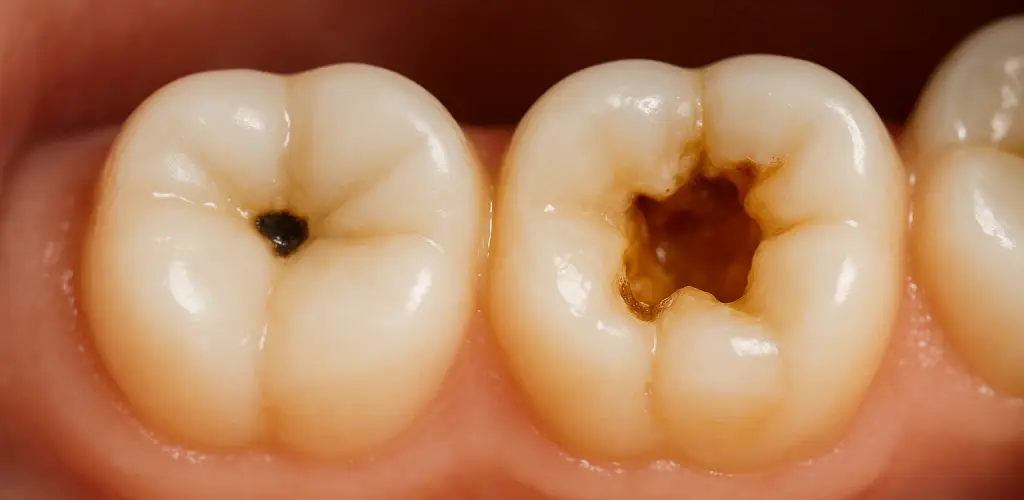
Decay affects the outer coating (enamel) or the inner layer (dentin).
Cavities, also known as caries or tooth decay, are a common dental issue affecting both adults and children. These dental issues form faster in children due to their teeth’s ‘temporary’ status.
It persists until they get their ‘permanent’ teeth, at which point it slows down. Certain habits or factors can make some people more vulnerable to it than others.
Read about the mouth-body link and How Dental Health Affects Overall Health.
Is it my Fault my Kid has Cavities?
It’s a common question parents ask themselves when they see their children suffering from cavities.
The answer is no! You’ll be surprised to learn that despite good habits and care, cavities still appear.
“Cavities aren’t a reflection of bad parenting; they’re actually the result of many small factors coming together. Parents must move past this question and think about treatment as soon as possible ”
— Dr. Alexander Heifitz
Several factors contribute to poor oral health in children, and no one factor outweighs the other. Oral hygiene, diet, genetics, and oral environment are a few of these factors.
Sometimes, maintaining oral hygiene cannot replace the need for preventative and diagnostic care. The good news is that dentists can help children prevent getting countless cavities at once.
What are the Signs of Cavities in Kids?
There are various signs that a child is suffering from dental cavities. Kids’ cavities are visible from the following symptoms:
- Darkened tooth appearance
- Formation of white spots on teeth
- Light brown color on the tooth
- Holes or damage to the tooth
These are the basic visible signs of cavities in children. There’s another list of symptoms that signal that immediate dental attention is necessary:
- Excessive pain and swelling
- Difficulty chewing and sensitivity to hot and cold items
- High fever, indicating an infection
- Pus leaking out from the tooth
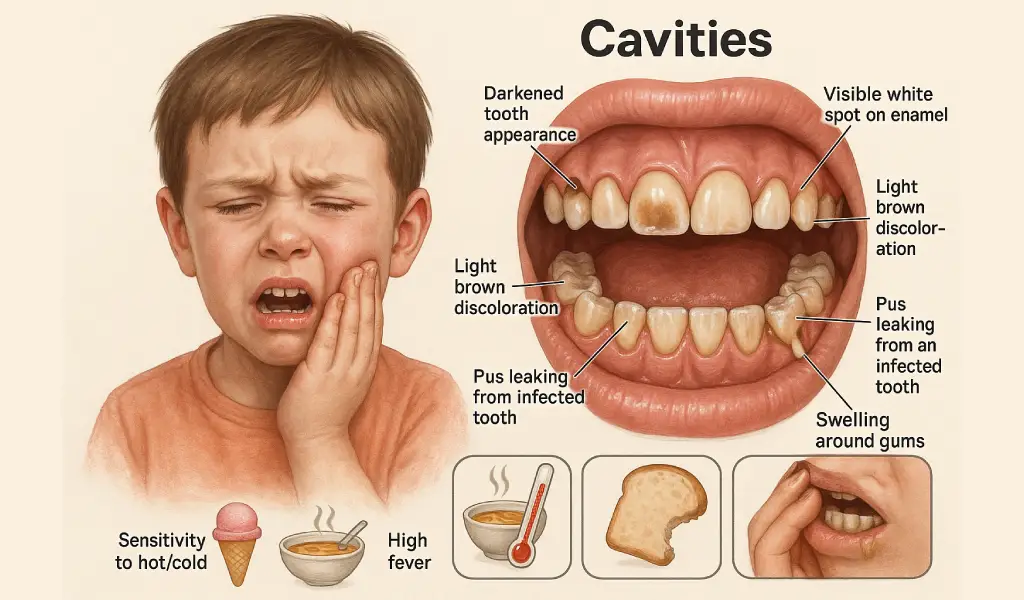
How to Treat Cavities in Baby Teeth Naturally?
Babies should be taken to the dentist between the ages of 6 months and 12 months. This is also the time their first teeth will erupt. Unfortunately, children, this young won’t be spared from caries.
“Natural approaches can slow down early tooth decay in baby teeth, but they must go hand-in-hand with professional dental care. Avoiding professional dental care can leave rare conditions undiagnosed, and treatable cavities untreated”
— Dr. Alexander Heifitz
Dentists say tooth decay can start as soon as the first tooth appears!
Although this sounds discouraging, parents can communicate with dentists to help their children. Here are some prevention steps to help avoid cavities in babies:
Step 1: Cleaning the Oral Palette
Using a clean, wet cloth, run it around the tongue, gums, and teeth of your baby. This process must be done after feeding and before bed. An additional cleaning is necessary after feeding your baby any sugar-containing medicine
Step 2: Avoid Sugary Food & Drinks
Picking what your baby or toddler drinks in their initial years is vital. A common culprit is juice; some juices are 100% real, while others are actually drinks. There is a significant difference in their sugar content. Pure 100% juice, occasionally, is okay only in quantities of less than 4 ounces.
Step 3: Brushing Habits
Use a small, soft-bristle toothbrush and a rice-grain amount of toothpaste when brushing kids’ teeth under 3 years.
Step 4: Weaning
Ideally, babies should be weaned off bottles at 12 months old and introduced to a cup. Also, mothers should not use a bottle as a pacifier.
How to Treat Cavities in Kids?
There are several ways children can be treated for tooth caries. These dental procedures exhaust all options parents have when it comes to addressing their kids’ cavities.
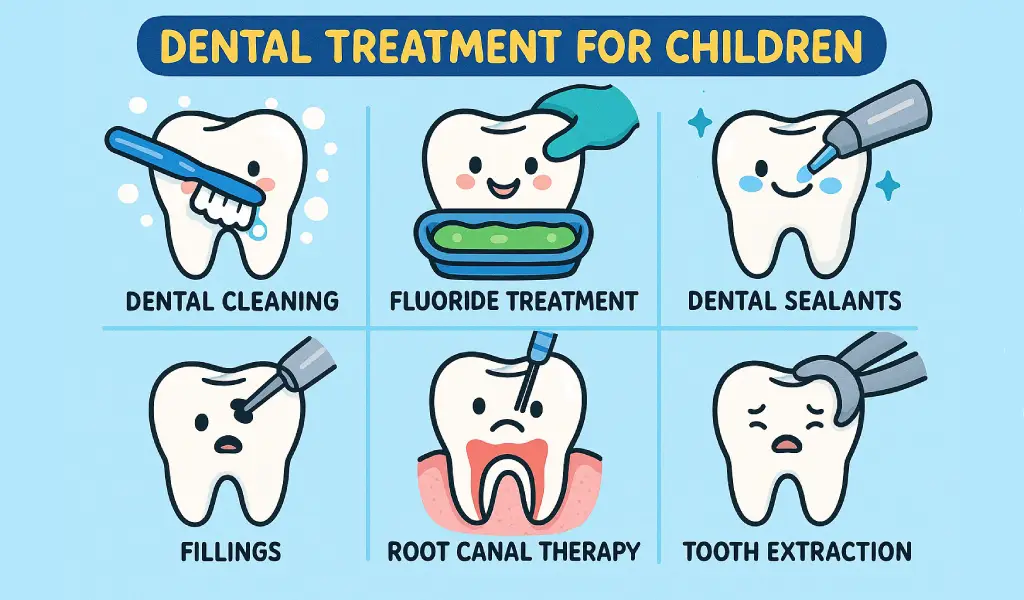
1. Cleaning
This is a simple and gentle dental cleaning that is part of adult and child preventive care. Your dentist will use modern technology and equipment to ensure a pediatric-friendly experience.
This process is essential to remove plaque and tartar. Without this cleaning, it could worsen existing cavities or create new ones.
2. Fluoride treatments
As the name may suggest, these treatments use fluoride. This substance is known for its ability to repair teeth. Using the remineralization process, fluoride can help reverse early symptoms of cavities.
Apart from the fluoride treatments, a dentist may also prescribe other fluoride-based products. This can include toothpaste, mouthwash, and drinking water with adequate fluoride levels.
3. Dental sealants
Dental sealants aren’t just a cavity treatment option for molars. Most dentists recognize them as suitable cavity prevention solutions.
In this treatment, dentists will seal up the surface of molars to create a smooth surface. It seals the cracks, stopping food from lodging in these areas and causing decay. The sealants act as shields and are appropriate for children aged 6 to 14.
4. Fillings
Dental fillings are an age-old treatment for cavities. New developments in dentistry have resulted in a better option called Composite fillings.
These composite fillings are more appealing and longer-lasting than traditional fillings. The special resin it is made from makes it last between 5 and 10 years. Of course, its longevity depends on care and a few other factors!
5. Root Canal Therapy
Parents aren’t aware that root canal therapy can save their child’s teeth. They also won’t know that preserving children’s primary teeth is an advantage. These teeth are essential in helping secondary teeth arise and grow in the correct position.
This treatment is also known as pulp therapy. It removes the tooth’s innermost material and seals it to preserve it from decay. The latest
Learn how modern Sweeps Laser Root Canal Therapy differs from traditional root canal treatment.
6. Tooth Extraction
Most parents know that some teeth can’t be saved. The tooth with severe decay may cause pain and can potentially lead to infection. Therefore, dentists may suggest a surgical extraction to fix the side effects of cavities.
These issues rarely happen and are a last resort. In some cases, a root canal can help eliminate the need for an extraction. Your pediatric dentist will make your child as comfortable as possible to avoid pain.
They may use local anesthesia to numb the area or sedation to make them sleep.
What are the Steps for 5-Year-Old Tooth Decay Treatment?
From age 5 and above, cavities can become more aggressive. It seems as if they appear overnight, and they can quite literally!
Step 1: Initial Dental Assessments
Treating a case of tooth decay in children starts with a consultation. Visit a pediatric dentist who specializes in treating children. They will conduct a physical examination of the tooth before taking the next step.
Step 2: Discussing & Selecting Treatment Options
Once the dentist is clear about the tooth’s condition, they’ll suggest some treatment options. If you aren’t sure about which treatment to select, your dentist will highlight the best one. Dentists will also detail the pros, cons, and possible risks.
Based on the tooth decay, they will proceed with fillings, sealants, cleaning, or fluoride treatment.
Step 3: Pain Relief Measures
After the first session, your dentist may recommend over-the-counter medications to relieve pain and discomfort. Most pediatric-grade treatments are simple, and dentists are gentle with kids. Therefore, these pain medications may not be necessary.
Step 4: Aftercare
Most treatments for kids’ cavities are completed in one session and rarely require another session. A follow-up will be necessary to check on the healing or status of the filling. It helps the dentist determine if other options are needed to stop further decay.
Step 5: Guidance on Cavity Prevention
It’s natural for dentists to offer advice about cavities in children. These experts know what foods and lifestyle habits that accelerate cavity formation in children. They can also teach kids how to brush correctly for maximum bacteria removal.
What are the Steps for 3-Year-Old Tooth Decay Treatment?
There are non-surgical treatments available to treat minor cases of gum disease. These are often quicker, faster-healing options for mild gingivitis.
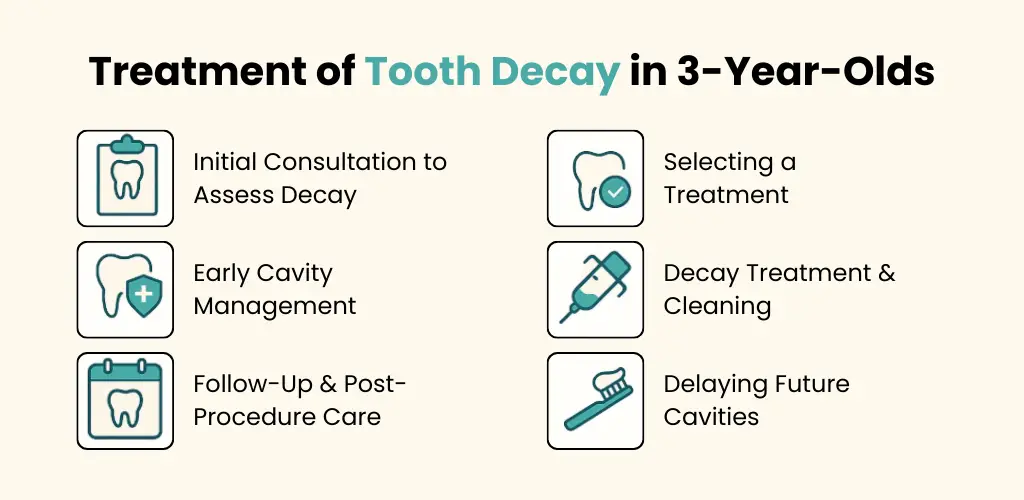
Step 1: Initial Consultation to Assess Decay
The first course of action is to assess the teeth. Here, the dentist identifies the decaying tooth and sees which other teeth are at risk.
Step 2: Selecting a Treatment
Once the assessment is complete, the dentist draws up a customized treatment plan. This will consist of the best 3-year-old tooth decay treatment option. Once this is drawn up, they will explain it to the parent to ensure they’re aware of the process.
Step 3: Early Cavity Management (Early Decay)
Early-stage tooth decay is easier to treat. Dental experts use fluoride treatments to subdue decay and strengthen the teeth.
Step 4: Decay Treatment (Advanced Decay)
Progressive decay will require more aggressive actions, such as fillings or crowns. These will prevent more tooth damage and loss of function.
When a tooth is damaged past the point of reversal, dentists will suggest tooth extractions.
Step 5: Pain Management
During these dental procedures, your dentist will do their best to make your child comfortable. This may require the use of local anesthesia, nitrous oxide (laughing gas), or even sedation. These options help your child remain still and calm til the procedure is complete.
Step 6: Follow-Up & Post-Procedure Care
Aftercare tips will help your toddler recover from the treatment quickly. It will also help give the teeth time to settle after their first-ever dental work.
A follow-up after some time allows the dentists to assess the results. Additional treatments may be necessary, depending on the success of the previous treatment.
Step 7: Delaying Future Cavities
Parents eager to prevent future activities in children 3 and younger can ask their dentist. Following the dentist’s advice about diet, oral care, and lifestyle habits is essential.
What Causes Cavities in Children?
Cavities in children occur due to oral bacteria, foods, saliva, or acid. Certain foods have a higher starch and sugar content than others. These harmful substances, in addition to uncontrolled populations of oral bacteria, are damaging.
- Sugar-Rich Diet
Candy, carbonated drinks, juices, cereals, and milk create acidic environments in the mouth. These conditions favor oral bacteria, which thrive in such acidic conditions. Sugars feed bacteria, while acids will eat away at the tooth’s enamel.
- Increased Oral Bacteria Populations Cavities occur when bacteria are allowed to thrive by creating favorable conditions for their multiplication. Conditions leading to excessive amounts of oral bacteria are those that are acidic and high in sugar.
A lack of control over expanding bacterial populations is a worrying sign. This is because such settings allow them to accelerate tooth decay. Preventing tooth decay is a lot easier and less costly than treating it.
- Poor Fluoride Intake
Fluoride can help cavity-prone children in various ways. It initiates the process, remineralization, where minerals like fluorapatite are deposited back onto teeth. This substance strengthens teeth by restoring enamel, the outer protective covering of teeth.
- Genetics
Families with a history of dental caries should expect the trait to continue down generations. There isn’t much parents can do to stop genetic predisposition to activities. All they can do is ensure that they help their child follow good oral care practices.
- Lack of Oral Hygiene
Poor brushing and flossing habits will contribute to cavity formation in kids. Dentists must work together with parents to teach children the correct way to brush. Using the wrong toothbrush and brushing method can:- Damage teeth enamel
- Prevent the removal of food bits
- Lead to failed attempts to remove bacteria and plaque
- Low Saliva Production
Saliva doesn’t get enough credit for the ways it helps control oral bacteria. It even plays a role in preventing oral conditions like gum disease. The tongue produces this substance, and it helps to:
- Dislodge food between teeth
- Releases enzymes that dissolve food particles
- It neutralizes acids in the mouth
- Holds minerals that can be helpful for remineralization
How do you Prevent Cavities in Children?
Cavities in kids are a common occurrence, and parents shouldn’t panic when they happen. But parents aren’t completely powerless in the matter. There are certain actions parents can take to lower the possibility of their children getting cavities.
1. Regular Dentist Check-Ups
Taking your child for regular checkups is crucial for treating and preventing tooth decay. This dental attention is also necessary to ensure children’s teeth are developing appropriately.
If they aren’t, your dentist can suggest orthodontic treatments to help teeth grow in the right position and direction.
2. Maintaining Oral Care
Another pillar for preventing the quick emergence of kids’ cavities is oral care. If you’ve been taking your child for oral exams, your dentist has probably made suggestions.
They may have noticed that a rough toothbrush is being used or an incorrect brushing technique. If your child is brushing once a day, they may suggest brushing twice a day.
3. Adjusting Diet
Food choice can be linked to faster formation of cavities. This makes it vital for parents to manage their children’s diet. They shouldn’t just look at what they are eating, but also when they’re eating it.
Sugary, carbonated, and starchy items should be reduced. When eaten, ensure your child brushes or rinses their mouth to avoid tooth decay.
4. Using Fluoride-Based Toothpastes
Brushing with toothpaste that contains fluoride works to reduce the rate of tooth decay. The majority of tap water contains fluoride.
Sometimes, dentists will request a sample so they can test the quantity. If the fluoride quantity is low, they will prescribe a fluoride supplement.
Conclusion
Cavities are a common problem affecting almost half of all children. The alarming thing is that they can develop even with the right care. This makes dental intervention necessary to treat and prevent kids’ cavities.
Visiting 65 Broadway Dental for children’s cavities allows you to access pain-free, child-friendly treatments. These include fillings, dental sealants, fluoride treatments, and, if severe, extractions.
FAQs
1. Is it normal for kids to have cavities?
Yes, it is very normal for children to have cavities. Their temporary teeth are more prone to decay than adult teeth.
2. How common is tooth decay in 5-year-olds?
While it is common, it may be concerning if it’s disrupting your child’s ability to eat or speak. Parents may have to seek a dentist’s assistance if this is the case.
3. How to fix kids' cavities?
Although cavities are common in children, there are a few fixes a dentist can perform. They include dental restorations and fillings. Some preventive measures are fluoride treatments and sealants.
4. Why does my kid get cavities so easily?
The reasons why your kid could be getting more cavities than normal are genetics, diet, and poor oral care.
5. What is the average age for a first cavity?
The first cavity can appear when a child gets their first tooth, which is between 6 and 12 months old. However, the average age for the first cavity to emerge is 2 – 4 years old.

Dr. Alexander Heifitz (Author)
Dr. Alexander Heifitz is the founder of 65 Broadway Dental in NYC, where he combines advanced dental expertise with a patient-first approach. He specializes in cosmetic and restorative treatments such as dental implants, veneers, Invisalign, and smile makeovers, helping New Yorkers achieve both oral health and confidence.
Booking An Appointment
Looking for a reliable dentist in Downtown NYC? Whether you need a routine cleaning, urgent care, or a full smile transformation — we’ve got you covered. We accept most PPO insurance plans and offer flexible scheduling.
+1 (212) 430-3888
Call for appointment
Walk-ins Welcome / Same-Day Appointments Available

Related Blogs

8 Steps to Perfect Your Brushing Technique Tonight
Perfect your brushing tonight with 8 dentist-approved steps for cleaner teeth, healthier gums, and a brighter, cavity-free smile.
Read More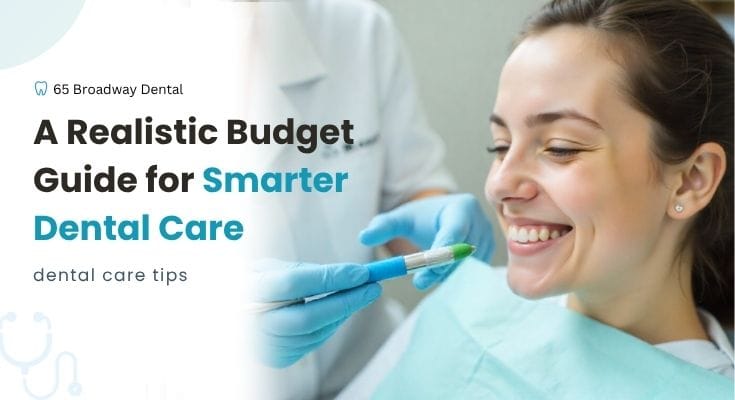
Dental Care on $50 a Month: A Realistic Budget Guide
Discover how to maintain great oral health on just $50 a month. A realistic, budget-friendly guide to affordable dental care without compromising your smile.
Read More